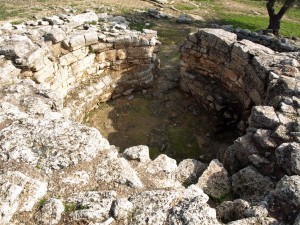Analysis and interpretation are crucial stages in the archaeological research process. After all, in order to interpret findings and apply appropriate theories, an archaeologist must be able to understand the data. Reconstructing the past involves a mix of both stages, as an archeologist focuses first on relationships and components within the data and then reconstructs data on a larger scale in order to interpret it.

Archaeologists are able to gain insight into past activities through interpretation based on three categories: technology, social systems, and ideology. Within the social systems division, settlement archaeology uses spatial distributions of activities to ultimately understand how societies functioned. Assuming that spatial patterns reflect past human behavior, archaeologists are able to map out the lives of previous societies. An incredible example of the analytical abilities settlement archaeology provides is the research of Chan Chan, Peru.
The ruins of Chan Chan are found in the Moche valley of Peru. This once great kingdom was the capital of the Chimu people and was the largest city in pre-Columbian America. This city was highly advanced with an economy based on agriculture, supported by irrigation ditches. Buildings were made of adobe brick. This thriving city left behind clues into social structure, stratification, and inequality by the architecture and layout of the city.

Three general types of housing made up the city of Chan Chan. Small units, presumably slum architecture, were found on the edges of the city. There were 35 intermediately sized, larger units that housed more elite members of society. The center of the city was comprised nine rectangular structures, separated from the rest of the areas by thick earthen walls. Since Chan Chan was small in terms of area with a high population density, the fact these palaces contained large amounts of space points to a hierarchical society. Another important aspect of the palaces was the limited amount of entrances. It can be inferred that the elite part of Chimu society had limited interactions with other parts of society. Inside the palaces, there were also burial sites, temples, kitchens, gardens, orchards, which shows the diversity in how space was used. Compared to the barrios of the city, the city center temples were constructed in complex, symmetrical ways, with elaborate designs. The barrios, however, were built more clumsily and simply. These three sections of architecture tells archaeologists how the Chimu society was divided.
Settlement archaeology, by analyzing the layout of the city spatially, has allowed interpretation of social interactions of the Chimu people. Society was very hierarchical, with power concentrated in only a few people. The decorations of the palaces also show that the elite had leisure time, as those who lived in the less-durable housing did not have time to spend on their living arrangements. These interpretations illuminate the intricacies of past cultures, as well as tracing the evolution and adaptation by examining cultures through time. By analyzing the settlements of the past, archaeologists are able to make valuable interpretations with relevant implications.
sources:
http://whc.unesco.org/en/list/366
http://www.britannica.com/EBchecked/topic/105252/Chan-Chan/
-Kathryn Marshall


